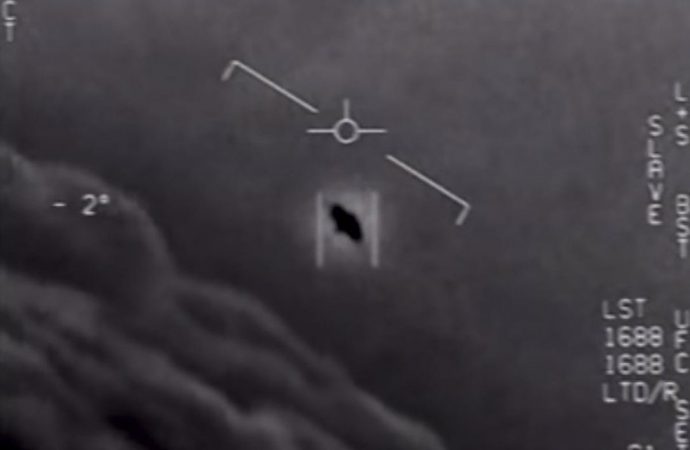It’s the stuff of UFO enthusiasts’ dreams — or conspiracy theorists’ nightmares.
Source: The Star
Unpublished U.S. military findings about “unidentified aerial phenomena” could soon be made public.
But America, it turns out, could learn a thing or two from Canada when it comes to transparency about flying saucers and the like.
Last week, the New York Times reported that the Pentagon has actively investigated reports of UFOs, citing a Senate committee report that called the program the “Unidentified Aerial Phenomenon Task Force.”
The Pentagon could be ordered to summarize and release the program’s findings if Congress passes the Intelligence Authorization Act, according to the report.
It makes for an exciting time for “ardent” fans of UFOs, acknowledges Chris Rutkowski, an enthusiast and the author of 10 books about how the phenomenon has played out in Canada over the years.
“Canada is actually ahead of the curve,” said Rutkowski, who lives in Winnipeg.
Last year, he donated his personal collection of UFO reports, including 10,000 Canadian government documents and 20,000 more from various agencies, to the University of Manitoba. He said he obtained some of the documents through access-to-information requests but others he has simply collected from Transport Canada reports, available online.
The Canadian government hosts a publicly searchable archive of government records about UFOs dating back to the 1950s.
About 9,000 government documents — ranging from defence department memos about “flying saucers” to RCMP reports by officers who investigated UFO sightings across the country — are available on the Library and Archives Canada website.
The documents “show a fairly consistent track record of Canadian official involvement and interest in the subject, almost to the present time,” Rutkowski said. “People in Canada have been way ahead of the United States in the sense that we’ve had a body of evidence and a body of documentation showing official interest in UFOs.”
Rutkowski says Canadian authorities have historically been more transparent than their U.S. counterparts and that Canadians saw UFOs more as a scientific curiosity rather than a military threat.
While the Canadian government probably hasn’t released everything it knows about UFOs, he said, there are sometimes good reasons to classify information, from military reasons to individual privacy concerns. It isn’t necessarily a sign of an “insidious” coverup, in his view.
“They’re not hiding information about ‘the little green guy,’ ” he said of the Canadian government.
From the 1950s to 1995, the National Research Council studied meteorites and often relied on reports of UFOs to find samples of fallen meteorites, said Rutkowski. Tracking reports of shooting lights in the sky sometimes meant investigating UFOs, he explained. The RCMP assisted the research council by investigating UFO reports and sending them to the scientists, said Rutkowski.
The Department of National Defence said sightings of unidentified airborne objects are reported to NAV Canada, the country’s civil air navigation service.
“As far as we are concerned, we only focus on credible threats, and this falls outside the scope of our operations,” DND said in an emailed statement.
Transport Canada compiles aviation reports from NAV Canada as well as other sources and enters them into a publicly searchable database called the Civil Aviation Daily Occurrence Reporting System.
Though synonymous with aliens, thanks in part to Hollywood, the term UFO can refer to many things, noted a spokesperson for Transport Canada — including “sightings of unmanned air vehicles (UAVs or drones), balloons, meteors, weather phenomena and birds,” adding that the term UFO “should not be interpreted to mean something of extraterrestrial origin.”
A search for “unidentified flying object” in Transport Canada’s Civil Aviation Daily Occurrence Reporting System yields 14 results.
One entry describes a flying object “the size and shape of a rugby ball” near Prince Rupert, B.C., and another cites a silver balloon-like object with “mechanical grooves” and “four blinking lights underneath” near Ottawa. In some cases, the North American Aerospace Defense Command (NORAD) was notified.
Rutkowsky collects reports of UFOs from across Canada and produces an annual summary of his findings. In 2019, 849 UFO reports were filed, following a pattern of decline in the number of UFO reports in the past decade.
In the United States, the study of UFOs often takes on a more militaristic tone, said Rutkowski.
“During the Cold War, there was a concern that what was being seen by people was an incursion by Russian jets,” Rutkowski said. Many of those military files were classified, giving rise to persistent conspiracy theories about government coverup of UFO-related findings and more.
Recent new stories about the U.S. Senate committee report and the possible release of previously classified information about unidentified flying objects has brought discussion about UFOs back into the mainstream, Rutkowski said.
Most astronomers are taking recent developments in the U.S. with a grain of salt, said Michael Reid, who teaches astronomy at the University of Toronto.
He said in his experience, reports of UFOs are “almost always one of two things — it’s either a planet, or it’s a satellite.”
In fact, astronomers at U of T generally spend less than one per cent of their time investigating UFOs, Reid said. But the university does sometimes receive reports of UFOs they can’t explain.
“Once in a while we get a call and we say, ‘Yeah, we don’t know what it is. Either your description wasn’t enough for us to figure out, or maybe you saw something that we can’t understand.’”
That type of uncertainty is not new for astronomers. In fact, dealing with the unknown is a central part of their job, Reid said.
“There are genuinely things up there that we don’t know what they are. If you’re an astronomer, that’s your whole business. That’s our discipline: trying to figure out what is going on in the cosmos.”
And it is “pretty possible” that intelligent life exists outside of Earth.
“There are billions and billions of Earth-like planets out there. It seems pretty possible that there could be intelligent life out there,” he said. “But it’s a really different question to ask — does that life visit Earth?”
Reid said Canada takes a more scientific approach to the UFO phenomena.
In fact, scientists around the world operate survey telescopes that constantly take photographs of the sky and are able to detect an incoming comet, an asteroid or a star explosion in another galaxy.
“It borders on incredulity that (these telescopes) would never spot anything whereas the American military does. We already practise the study of the unknown in a very scientific way.”
Source: The Star

































Leave a Comment
You must be logged in to post a comment.